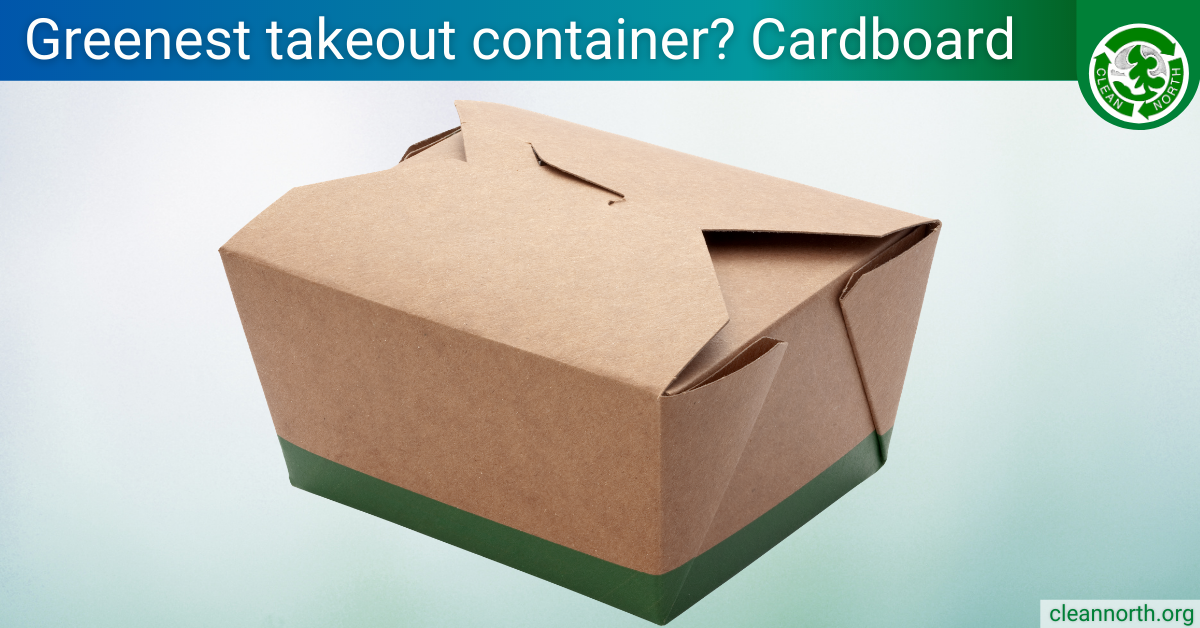
Short answer: Cardboard. Look for sustainable sources and recycled content, and try to recycle it. Please avoid so-called compostable plastic — it’s not the answer (at least not yet). Read on for details!
Single-use plastic
Plastics take centuries to break down and can release toxic chemicals into the environment. And while many plastic food containers have recycling symbols on them, leading us to believe they are recyclable, our local recycling facility here in the Sault does not accept any plastic food containers (only bottles and jars marked #1 or #2).
So-called biodegradable or compostable plastics are no better! Three key reasons:
- We don’t have municipal composting here in the Sault, and even if we did, most municipal composting systems can’t handle bioplastics. They take too much time and heat to break down (and sometimes contain nasty chemicals).
- The content of some compostable plastics is concerning enough that compost from facilities that accept compostable plastics cannot be used on organic crops.
- People don’t understand the difference between regular and compostable plastics and often put compostable ones in recycling bins, contaminating this waste stream and possibly causing large contaminated loads of recyclables to end up in the landfill.
- Some of these plastics don’t actually biodegrade but instead break into microplastic bits. Invisible doesn’t mean it’s safe for the environment.
Rigid plastic food containers can be used for other purposes, for example, storing leftovers. But that’s not a compelling reason to use them.
Single-use styrofoam containers
These are not recyclable and take a long time to break down in landfills. And when a food/beverage is hot, styrene, a chemical that comes with health risks, may leach into it.
Single-use cardboard
Cardboard can have some environmental impact during manufacture and shipping (paper/cardboard making involves heavy use of chemicals). However, cardboard (especially from sustainable sources) has minimal impact on the environment after production. Clean cardboard can be recycled or even composted (when composting, avoid paper/cardboard items with a glossy coating, coloured ink, or plastic inner lining).
Disposing of soiled cardboard that is caked with grease or food is complicated. We’d like to see paper/cardboard not end up in the landfill because it’s organic, and organic matter in landfills gives off methane, a powerful greenhouse gas. But putting soiled paper/cardboard in recycling bins can gum up recycling equipment. When recycling cardboard food containers, rinse well.
Single-use foil containers
These containers pose minimal risk to the environment after production. But producing aluminum involves mining bauxite ore (a dirty industry) and takes a lot of electricity. In many places where aluminum is produced, that electricity is generated by coal.
Foil can be reused or recycled (if clean). But how often do people reuse or recycle foil containers? They mostly end up in the trash.
Reusable takeout containers
Some companies are moving towards reusable food packaging like Go Box…but that probably will not be within reach of small business owners in the Sault for a long time.
What about cutlery?
Similar issues. Regular plastic and so-called compostable plastic are a problem. They both end up in the landfill and take a long time to break down. Most of us who compost at home do not have conditions that allow compostable plastic to break down. Disposable wood cutlery/beverage stirrers from sustainable sources are better options.
And bags?
Check out this Clean North blog post about bag options.
And finally, check out this article about green innovations in packaging/ and this one about Ontario companies innovating reusable takeout containers.
Comments or questions? Email us at cleannorth.org.




